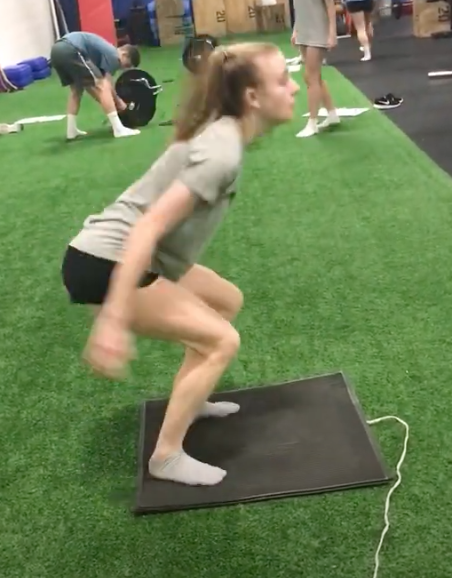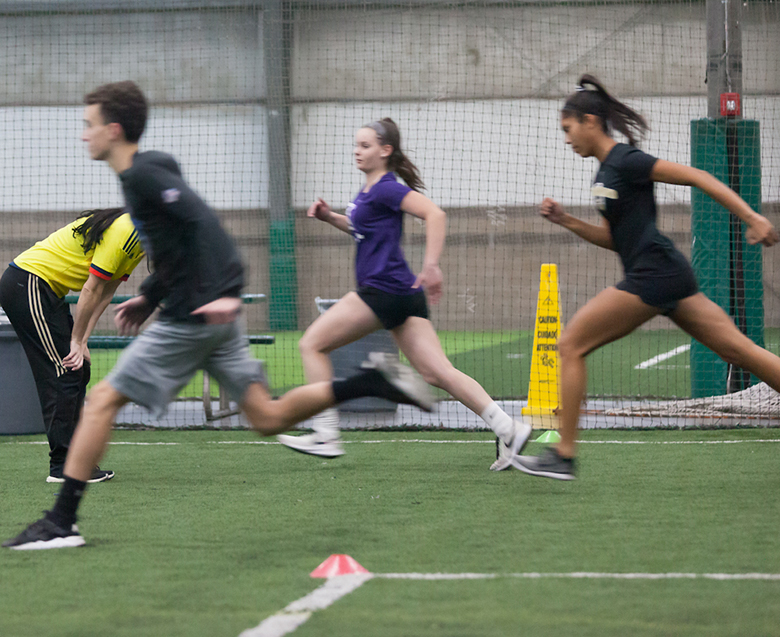
08 Jun Coaching Female Athletes Plyometrics: Stop Making Them Sore
Thump.
Thud.
Thump.
Repeat x 1000 reps.
‘Why do I keep hearing that sound?’ I thought. ‘And why is it so darn loud?’
I was walking through the park, taking what I thought would be a tranquil stroll on a Saturday morning.
As I continued wandering, I noticed a pre-adolescent girls’ soccer training session being held on stadium steps and a concrete track.
The thump-thud noises sounded similar to the ominous stomps of Balrog approaching the Fellowship in Lord of the Rings.

As terrifying as it was, I stuck around to observe what was going on.
Stadium steps runs x 60 sec, superset with broad jumps x 20, jog around the track, superset with burpees x 20, no break, rinse and repeat.
My eyes widened with fear, my gut churned, and my fists clenched.
Of course, I only witnessed all but 5 minutes of this, but I couldn’t help but wonder, ‘what was going on before I arrived? Did they warm up? How much longer will they endure? Why? WHY?!’
And even 5 minutes of this nonsense is detrimental for young female athletes.
As a performance coach who is passionate about helping girls train safely and effectively during their growth spurts, it pained me to see them going through the excruciating demands of plyometric training stupidity.
Yeah, you heard me.
Endless jumps, burpees, and stair runs are NOT plyometric training. They're lazy programming that fatigue our young athletes, rather than build them into explosive beasts. Share on XAnd I know all coaches long for their players to become blistering fast. I know all coaches hope their players become powerful. I know all coaches want their players to be able to handle the dynamic actions of the game. I know all coaches want their girls healthy and durable.
After all, team sports encompass rapid movements – goal scoring, sprinting, accelerating, counter attacking, juking, faking, cutting, diving, and jumping – that decide wins and losses, as well as fill the game with color and exuberance.

When we look at all of these movements, they occur no longer than the length of six seconds, so why do we train them for longer?
Why do we program “agility” drills that last 30 seconds in duration?
Why do we program “plyometric” drills that turn into a 10-minute circuit with no breaks?
Why do we program so much jumping, bounding, and hopping without nailing down movement competency first?
I urge coaches to ask themselves what their goal is when programming any form of jumping at a practice. Share on XIs it to cause fatigue?
Is it to make players sweat?
Is it to give teenage girls more patellar problems?
Is it to cause overuse injury?
Or is it to tap into fast twitch muscle recruitment?
Is it to develop power?
Is it to build rate of force development?

Always remember the goal.
Now, let’s talk about speed training: it is the best form of plyometric training. Nothing beats the as fast as .08 second ground contact time of a sprint.
Too, it’s critical to understand that sprint training is very taxing on the nervous system, and when the nervous system is fatigued, the athlete cannot optimize a concentric-eccentric muscle action in order to create more vertical force. This is why all speed drills must have the prop work-to-rest times in place, otherwise we mistake it for aerobic training and other energy systems.
I beg everyone: REST THE FULL TIME.
Too often, I see folks rushing the rest time and turning a speed drill into a conditioning drill.
Taking the full rest is half the battle when developing speed in young female athletes. Share on XOh! And don’t know what to do for two minutes?
Get a dynamic stretch. Grab a sip of water. Talk to someone. Work on breathing. Admire the sunset. Do the Renegade.
If you want more information on the components of speed training, from technique, to vertical force production, to posture, to various drills, read my article Soccer Players: Get FAST.
Also, check out track coach Tony Holler’s epic article 3 Ways To Transform Slow To Fast. Take it from a man who has timed over a bajillion 40-yard dashes and has trained thousands of sprinters, you better read this word-for-word before you ask any of us performance coaches for a “quick fix” for speed development.
Anyway.
Wow, I got sidetracked!
This was about to turn into a speed article, but I know you came here for plyometrics, specifically for the female athlete population.
Just like a quick, quality set of vertical jumps, let’s do this in a succinct, bullet point form.
Yes, let’s.
1. Master technique.
The pre-adolescent and adolescent female athlete population are both experiencing a myriad of physiological changes that continue until full maturation is reached – bone growth, menarche, coordination disturbances, decrease in balance, decrease in core stability and body control, and increase in fat mass.
A study done by suggests that trunk dominant core stability training improves landing kinetics, and may reduce lower extremity injury risk in female athletes (Araujo et al. 2015).
It’s imperative they learn trunk control first before aiming for the stars with jump height and tons of sets and reps.
With so many dynamic changes occurring in the body, female athletes must master plyometric technique and learn to pump the brakes, and build a foundation for tendons to handle high forces. Share on XAs a starting point, ensuring girls hone in on “athletic stance” first, when the hips are piked back into a hinge position, posture is upright, and knees are softly bent, allows them to get into a position where they recruit all of the muscles involved in absorbing force – the quadriceps, the gluteals, the hamstrings, and the anterior core all working together simultaneously.
Once they nail this down, then we can begin to work on handling eccentric muscle actions from the landing. As track coach Tony Holler says, “whatever force you can absorb, you can generate.”
Start here first:
Moving to single leg plyometrics, it’s the same game: get comfy with the eccentric component first.
And then guess what?
Yeah, you read me like a book: add in the concentric component.
The mastery of technique with plyometrics is also teaching athletes spatial awareness – an athlete’s control of their limbs in space during movement.
Are they in control of their posture when landing? Or are they falling forward? Loading their knee joint too much? Or are the falling backward, unable to recruit the gluteals, hamstrings and quadriceps?
Or are they able to maintain an athletic position? Are they able to push through the mid-foot? Are they able to keep posture from collapsing? Are they able to progress from linear to lateral plyos?
If we want our young female athletes to move well, we must teach them how to control their bodies in space. Share on X
This way, we can progress from vertical double-leg jumps, to vertical single-leg jumps, to lateral double-leg jumps, to lateral single-leg jumps, and transverse jumps, and synchronized jumps for kicks and giggles.
I’d be remiss not to mention plyometric training is neuromuscular training, not hypertrophy or strength training.
The nervous system is the prime driver in elasticity and the ability to quickly go from eccentric to concentric action (jump, land, explode back up). We don’t want fatigue…we want FAST! Quick duration, long rest. Then go FAST again.
With that said, let’s move to the next point…
2. Produce more force.
After hammering down technique, it’s time for female athletes to produce force. After all, the intent of plyometrics is muscle recruitment (fast twitch), muscle coordination and ground reaction force.
This is why the work-to-rest is critically important, especially in loading jumps.
One way to do this is to ensure athletes have a rapid bounce in their jumps. I like to to cue with snapping my fingers rapidly so they keep up with the speed from an auditory cue.
Another external cue that has worked magic has been the word “bounce.” There’s something that sticks with young female athletes when you tell them to be bouncy in their hops like a pogo stick.
As far as assessment, for vertical jumps, we will do a 5x jump and take the highest height. An excellent score for pre-adolescent females is > 13-15- inches and adolescent > 20-22 inches.
For broad jumps, we will do a 3x broad and take the measurement of the back heel on third landing. An excellent score for pre-adolescents is > 16 feet, and an excellent score for adolescents is > 20-21 feet.
As you can see, both of these assessments up the ante on ground forces and the athletes are going for distance and height.
Studies show that core stability provides distal mobility, spinal stability and proximal stability (Akuthota et al. 2008), so we must keep importance of the effect on lower body kinematics when more forces are applied to the muscles and tendons.
With the growing female athlete population, patellar pain in the knee runs rampant, so we want to avoid high forces placed on top of bad form – falling forward, core collapsing, weight on the toes.
Instead, maintaining posture and stable core, and pushing the weight through the ball of the foot.
3. Progress with load and vector angles.
I know we all want the cool jumps we see splashed on social media.
But did we get the form down?
Okay, good.
There are several ways to progress plyometrics.
- Up duration (ground contacts done rapidly with 3-5 second duration, aiming for 10-12 ground contacts, during General Preparation Phase to prepare tendons and elastic power)
- Changing direction of force (because power is vector specific and team sports are multi-planar)!
Here are a few examples:
– Add load (add depth jumps or up weight to train max velocity and explosive power, mainly for the adolescent female athlete during the performance phase)
Keep in mind that when you add load, the reps must still be rapid. If they aren’t after coaching cues, the load is too heavy.
Whatever progression you opt for, keep speed in mind.
4. Be meticulous with work-to-rest times.
I’m going to be to-the-point here: keep the nervous system in mind. Plyometrics will tax it the most, so chill out and rest between sets. Don’t be a hero.
Ideally, a 1:10 or 1:12 work-to-rest time is best, depending on the work you opt for. A depth jump has a greater eccentric demand, so a longer rest time bodes well (1:12). A mini vertical jump series may call for a shorter rest time (1:10).
5. ‘But, but, what about running?’
Yes, running has concentric-eccentric muscle actions when we trot through a long distance run or play a small-sided game, but when we look at the energy systems, which one are we training?
Are we truly optimizing the stretch shortening cycle and making the ground contact time rapid? Sprinting does this. Lateral Bounding does this. Pogo Hops do this.
As long as we keep the reps low, intensive and bouncy, we’re doing our job with plyometric training.
It’s always separate training.
The energy systems cannot be worked on at the same time. Just like when you’re driving a car, if you’re in first gear, you’re accelerating (ATP-CP), and you can’t be slugging along simultaneously. If you’re in fourth gear, you’re cruising (aerobic), and you can’t be accelerating at the same time.
The energy systems cannot be worked on at the same time. Just like when you're driving a car, if you're in first gear, you're accelerating (ATP-CP), and you can't be slugging along simultaneously. If you're in fourth gear, you're… Share on XWhich brings me back to the question: what is the goal of the training session? What energy system is being trained? What muscle actions are being tapped into?
My biggest fear is a high volume of plyometrics, namely, vertical jumps, broad jumps, frog jumps, bounds and more in the form of an aerobic circuit – for young female athletes.
We have to remember that stability and quality movement cannot wane for this age group. Pelvic control matters. Athletic stance matters. Core stability matters. Posture matters.
Before I wrap this up, here are some bullet points to keep in mind as far as programming:
– Bilateral to unilateral
– Sagittal, Frontal, Transverse
– Learn to absorb force, then generate force
– Never perform under fatigue
– Quality over quantity
– Light intensity plyos –> higher reps (8-10) GPP
– Medium intensity plyos —> medium reps (5-7) GPP
– High intensity plyos —> low reps (2-4) Max V
– For young female athletes, 20-40 ground contacts a session is a nice sweet spot. No more than that.
Let me know how they do, and how excited they are about truly improving power, rather than enduring a constant state of soreness and defeat.
Enjoy.
For more power, strength and speed programming for female athletes, get Total Youth Soccer Fitness 365, a year-round youth fitness program HERE

REFERENCES
Akuthota V, Ferreiro A, Moore T, Fredericson M. Core stability exercise principles. Curr Sport Med Report. 2008;7:39–44
Araujo, S., Cohen, D., & Hayes, L. (2015). Six weeks of core stability training improves landing kinetics among female capoeira athletes: a pilot study. Journal of human kinetics, 45, 27–37. https://doi.org/10.1515/hukin-2015-0004


Stuff to Read While You're Stuck at Home Not Wearing Pants: 6/12/20 | Your World
Posted at 11:19h, 13 June[…] Coaching Female Athletes Plyometrics: Stop Making Them Sore – Erica Suter […]
Stuff to Read While You’re Stuck at Home Not Wearing Pants: 6/12/20
Posted at 03:52h, 15 July[…] Coaching Female Athletes Plyometrics: Stop Making Them Sore – Erica Suter […]